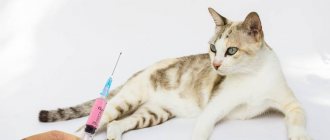If parasites appear in cats, they can be localized on the skin, under the skin and inside the body. Depending on the location of the development of the pathological process, symptoms are manifested by the appearance of wounds and boils on the skin, itching, intestinal upset, cough, and decreased immunity. Some species can be transmitted to humans, so the owner should take the animal to the veterinarian at the first sign. who will prescribe medications and give preventive recommendations.
According to veterinarians, internal parasites live in 40% of domestic cats.
Skin parasites (external)
The most common parasites that live on the fur and skin of pets are fleas, ticks and lice.
Fleas
Fleas feed on the blood of cats and kittens, leaving behind characteristic black dots (excrement) that some pet owners mistake for laying eggs. In fact, flea eggs are found in secluded places in the apartment (under baseboards, in carpets and animal bedding, in the upholstery of upholstered furniture) and look like colorless small grains. The eggs transform into larvae within 2-14 days. And after a few more days or months (depending on conditions), the larva becomes an adult.
Fleas are unique insects. They can jump to heights hundreds of times greater than their own size, and can go without food for up to several months (this applies to adult individuals). If there are no animals nearby, they also feed on human blood. The favorite habitats on the body of cats for fleas are the neck, withers, tail, stomach, sides, and head.
Lice
Insects with a dense body, flattened downwards, translucent, with a triangular head. They feed on particles of skin and fur, so their favorite habitats are places with increased hairiness. But lice also suck blood. Hair (wool) is not only food, lice attach their eggs (nits) to it, up to 7 per day. New insects hatch from the eggs after a few days.
Ticks
They come in ixodic and auricular types. They are considered the most dangerous insects that parasitize the body of an animal. Ticks have a flat body 0.3-0.7 mm long, but a female that has eaten enough becomes similar in shape to a bean. Hungry ticks are white or brownish in color, while engorged ticks turn grayish. Ticks live in the ears, on the back, and chin. The female lays up to 5 eggs per day, from which larvae appear on the 4th day, then nymphs.
The ear mite is an external parasite with an oval-shaped body, dirty yellow in color, up to 0.6 mm long. It is distinguished by powerful jaws and short legs (4 pairs). It can settle inside the ear and directly in the auricle. Causes scabies, ear inflammation.
The Ixodid tick is a parasite with a flat oval body. Females are spotted, males are brownish-gray. They feed on the blood of cats.
lice eaters
An insect with a body 1-2 mm long, light brown in color (it can also be whitish or yellowish). Refers to external skin parasites. They are distinguished by a large head, undeveloped chest and legs with hooks at the end. It parasitizes the hair of cats, causing hair loss, the formation of weeping wounds, and allergies. Infection occurs through contact with a sick animal or parasite eggs from the soil.
Possible complications in the absence of prevention and treatment
- Fleas provoke skin inflammation because they feed on animal skin flakes and blood. Ticks, fleas and mosquitoes are the source of a vector-borne infection called infectious anemia (hemobartonellosis). Its causative agent is hemobartonella. It becomes more active in the spring and summer due to insect vectors. Animals experience anxiety, pain, and blood loss is life-threatening.
- Helminths affect the cat's immune status. She can get pneumonia, sepsis, and get toxic liver damage.
- A sick pet can infect other animals living in the house, small children and adults.
Monitor your pet’s behavior and do not let the situation take its course if you suspect an infection. Timely prevention is a guarantee of the cat’s health and well-being.
Internal parasites
These types of parasites live in the internal organs of representatives of the cat family, affecting the liver, gall bladder, and intestines.
The most common ones are:
1) Cestodes.
Reach up to 70 cm in length. The walls of the small intestine are affected. The larvae resemble sesame seeds in appearance. They come out with the animal's feces. If the infection is severe, the larvae can be found in the vomit or on the cat's bedding.
2) Cucumber tapeworm.
A parasite reaching up to 30 cm in length. Lives in the intestines. It can cause a very dangerous disease – dipylidosis, which leads to disturbances in the functioning of the digestive system. Transmitted from carriers (fleas, sick animals).
3) Roundworms.
These are roundworms that reach a length of up to half a meter. An animal becomes infected by ingesting roundworm eggs. In small quantities, roundworms do not cause discomfort in the animal, but in advanced cases, alarming symptoms can be noticed (vomiting, the appearance of worms in the feces). They move through the small intestine and can clog it if there are too many of them.
Danger to humans
There are helminthiases that can be transmitted from pets to humans:
- alveococcosis;
- diphyllobothriasis;
- dipylidosis;
- dirofilariasis;
- toxascariasis.
The main route by which helminths are transmitted to humans is through food and through contaminated hands. The above diseases lead to severe illness and even death. Therefore, deworming of domestic animals is also a primary measure to prevent human infection.
Symptoms of parasites in a cat
Symptoms of parasites in cats do not always appear suddenly. The owner may not understand that the pet has been attacked by parasites.
It is worth paying attention to the following signs:
- Anxiety. The cat is constantly itching, licking, biting its fur;
- Wounds, bleeding places when scratched, baldness;
- The appearance of insects on wool, their excrement, nits;
- Brown crusts in the ears (due to ear mites), redness and soreness of the auricle;
- The appearance of flea excrement and adult individuals (brown shiny insects with a body flattened on the sides and long hind legs) on the animal’s fur.
Internal parasites do not cause such severe symptoms as external parasites.
Their presence is evidenced by:
- Constant vomiting;
- Refusal to eat;
- Strong general weight loss, but at the same time the stomach becomes disproportionately bloated;
- Diarrhea;
- Apathy;
- Stunted growth of young cats;
- Purulent discharge from the eyes.
These are alarming symptoms; it is necessary to show the animal to a veterinarian, so that after examination and assessment of the condition, he can prescribe a remedy for parasites for cats and recommend an individual dosage.
Why are worms dangerous for cats?
Developing in the cat’s body, worms cause enormous harm to the animal’s body. Firstly, they injure the mucous membrane of the digestive tract mechanically - they gnaw and pierce the intestinal walls with their spines and teeth. Penetrating into organs, they disrupt the structure of tissues and cells, limiting their functional activity. Sometimes the worms multiply to such an extent that they block the lumen of the small intestine, causing its obstruction.
The damaged tissues of the organs in which the parasites live gradually decompose. The released toxic compounds are carried by the bloodstream, leading to poisoning of the entire animal’s body. In addition, the worms themselves release toxins during their life processes and during decomposition after death within the body.
If a cat has worms, its immune system is severely affected. A weakened pet is unable to fight other infections, which is the cause of the development of various bacterial, viral and fungal diseases.
In the case of abundant reproduction of worms, the animal’s psyche also undergoes significant changes. Constant itching, pain and other sensations lead to the fact that the cat becomes nervous and irritable, its sleep is disturbed and its appetite disappears.
Treatment
You can get rid of external parasites yourself. There are many good veterinary medications on the market for fleas, lice, and ticks for adult animals and kittens. They come with detailed instructions, so it is impossible to make a mistake with the dosage. Treating a cat against parasites is carried out simultaneously with disinfection of the pet’s apartment and bedding.
To get rid of ticks, fleas, and lice eaters, special alcohol and oil drops are used on the withers and collar, soaked in essential oils. Shampoos, ointments, and sprays containing chlorhexidine and benzoyl peroxide are used. Additionally (as prescribed by a veterinarian), immunostimulants are used. Secondary infection requires antibacterial therapy.
Treatment of helminthiasis is carried out with anthelmintic drugs. They are available in tablets and as a paste in special dispensing syringes. Cats are given the drug once in the morning feeding. Cucumber tapeworm is treated with the help of febantel and praziquantel and simultaneous treatment of the animal's fur for fleas.
Parasites of domestic cats are an integral part of their lives.
Even good daily care cannot save you from them. After all, parasite eggs are present everywhere, in the soil, raw food, and in the cracks of the floors. People can bring them on clothes and shoes from the street. The salvation is constant prevention and regular examination of your pet by a veterinarian. Share with friends:
Diagnosis of helminthic infestations
It is not difficult to guess that a domestic cat has worms if they (or their particles) come out along with feces or vomit.
Otherwise, if the above symptoms appear, and also periodically as a preventive measure, you should contact a veterinary clinic for diagnosis. It is better if the owner brings the animal directly to the veterinarian, because feces alone are in most cases not enough to detect parasites. This may be due both to the localization of helminths and to their insufficient maturity, when the worms are not yet able to lay eggs. Your pet's blood will be taken for laboratory testing and, if necessary, a sputum test will be prescribed. In some cases, the doctor may refer the cat for an X-ray examination of the lungs or an ultrasound examination of the liver and heart. In the process of identifying helminthiasis, they are differentiated from diseases of internal organs, poisoning, and colds.
Anthelmintics
There are many modern effective anthelmintic drugs. They differ in their spectrum of action: some drugs kill only one type of parasite, while most act in a complex manner.
Based on the form of use, anti-worm medications are divided into several groups, and here you will have to experimentally find out which option is best for your pet.
Most often you can buy tablets in pet stores, such as:
- Drontal, cestal - acts on round and tapeworms, one tablet is given per 4 kg of animal weight;
- Milbemax/Milprazone is a complex-action drug that is destructive to both adult worms and their larvae; effective not only against worms that have settled in the intestines, but also in blood vessels and the heart;
- Dirofen - has a pronounced complex effect, but is especially effective against nematodes and tapeworms; It is also available in the form of a suspension and paste.
When giving medicine, under no circumstances should you frighten the animal, squeeze it, or hold it forcibly. Gentle stroking of the withers and neck will calm the pet, and then you can gently open its mouth and quickly place a pre-prepared tablet on the root of the tongue. After this, you need to close your mouth and, trying to hold her head up, lightly stroke her neck, encouraging her to make a swallowing movement.
If your pet stubbornly spits out the tablet, you can crush the drug and either mix it with your favorite cat treat, or dilute it with water and carefully inject it into the mouth from a syringe (without a needle!).
Suspensions
Suspensions are more convenient for use. Included with the medicine is an atraumatic syringe, with which it is not only easy to measure the required amount of the medicine, but also to quickly give the medicine to the cat. The main thing is to also try to get it on the root of the tongue so that the pet swallows the suspension.
The most common suspensions are Prasitel, Prazicide and Dirofen. Prazitel has a complex effect, killing parasites at any stage of development. Another advantage of this suspension is the absence of any taste.
Drops on the withers
Another type of anthelmintic drugs is drops on the withers: Stroghold. The medicine according to the dosage is applied to the withers of the animal, after a few days the procedure is repeated.
Routes of infection and general signs of pathology
Most often, parasitic worms enter a cat's body orally, that is, through the mouth. An animal can eat a sick bird or mouse, plants, spoiled food, or drink from dirty water bodies.
You can also become infected with worms from a cat that is already sick. Another method of transmission of parasites is transdermal and intrauterine infection.
The clinical picture of almost all types of worms is the same. First of all, these worms have a negative effect on the organs of the digestive system. The pet refuses to eat, begins to lose weight, and becomes weak. He doesn't want to move, his fur is getting dull.
© shutterstock
Vomiting, nausea, problems with stool, itching in the anal area, gas formation, and blood in the feces are often observed. You can also find the parasites themselves near the anus . When the doctor checks your pet, he will notice that the cat's liver is slightly enlarged.
Photo gallery
Photo 1. Anti-worm medication
Photo 2. One of the ways of infection with helminths
Photo 3. Types of helminths
Prevention of helminthiasis
To prevent the appearance of worms in cats, it is enough to adhere to the following preventive rules.
- Avoid contact of your pet with unfamiliar or infected animals.
- When returning from the street, put your shoes in a separate closed place, not allowing the cat to sniff them. Wipe the hallway floor several times a day using disinfectants.
- Regardless of whether the cat goes outside or not, treat it with external products against fleas and other parasites.
- Eliminate raw fish from your mustachioed friend’s diet.
- Wash the tray and food bowl thoroughly and regularly.
The harmfulness of ectoparasites
The main problems that ectoparasites create are the following:
- Loss of rest, sleep, appetite due to unbearable itching.
- Infection with infectious and invasive diseases transmitted by insects.
- Blood loss.
Insects that parasitize the skin of cats and dogs can cause the following diseases:
- Allergy.
- Piroplasmosis.
- Borreliosis.
- Bartonellosis.
- Hepatozoonosis.
- Ehrlichosis.
A tick that has drunk blood
The bite weakens the dog, making it defenseless against staphylococcus, which is common to the skin. A secondary infection develops. Among cat diseases transmitted through a tick bite, the most dangerous are Hemobartonellosis and Piroplasmosis.
When not to deworm
There are several situations when you need to wait a little while treating cats for worms:
- serious condition of the pet;
- exacerbation of infectious diseases;
- cat pregnancy;
- lactation period;
- newborn kittens (usually age restrictions are indicated in the annotation for the drug).
It may also be difficult to deworm an aging cat. At this age, an animal should be treated for worms only in consultation with a specialist.
How to give your cat deworming medicine
Many owners are faced with the problem of how to give a pill to a cat. Pets resist in every possible way the owners’ attempts to open their mouths and push an incomprehensible bitter thing into it. To prevent physical and mental injury on both sides, you can use a number of proven techniques:
- crush the tablet into powder and pour it into your mouth;
- dissolve the tablet in a small volume of water, draw it into a syringe and pour it into the cat’s mouth;
- use the tablet dispenser.
How to properly rid a cat of worms
In order for your pet to be treated for helminths with the greatest effectiveness, firstly, you should carefully study the instructions for the medicinal product. It is important to strictly follow the dosage recommended by the veterinarian or the annotation (in case of self-therapy). Before starting treatment for helminthic infestation, the animal must be treated for external parasites.
Some cats manage to hold the pill in their mouth and then spit it out, so the owner must not only place the medicine in the pet's mouth, but also make sure that it is swallowed.
In most cases, deworming medication is given to the cat twice, with an interval of two weeks. This is due to the life cycle of parasites. If the disease is advanced, the doctor may prescribe longer therapy.
After deworming, you must make sure that the activities were successful. This will require repeated control tests.











